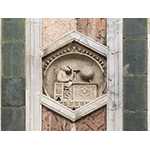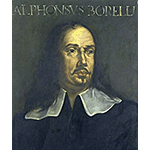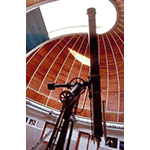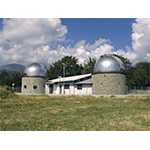Astronomy in Tuscany

Since the dawn of time, man has observed the complex movements of the heavenly bodies with wonder and fascination. Over the centuries, astronomy acquired an increasingly scientific nature, thanks also to the perfecting of optical instruments and those of measurement. Literary works and sundials bear witness to the early astronomical culture in Tuscan, starting already in the Middle Ages. It was this cultural humus that was to produce, in the following centuries, personages destined to revolutionize the history of this science.
Astronomy in the Florentine Baptistery
The Tuscan tradition of astronomy can be traced starting from the Middle Ages. One of the oldest surviving astronomical instruments is, in fact, an ancient inlaid marble placed, around the year 1000, in the Florentine Baptistry of San Giovanni, near the North Door. It marked the summer solstice, testifying to scientific interest in the apparent motion of the Sun. During the 13th century the marble was moved to the east side of the Baptistery, making it now impossible to evaluate its precision.
Astronomy and astrology
In the Middle Ages, astronomy was largely subordinated to astrology, to which it provided technical support for calculating the motion of the celestial bodies. One of the most authoritative treatise writers was Guido Bonatti, whose works dealt with the most important problems of astrology and astronomy. Bonatti frequently stayed in Tuscany, and was even mentioned by Dante, who however put him in the infernal ring reserved for wizards and magicians.

Astronomy in the Divine Comedy
In the Divine Comedy, some moments of the voyage to the other world are marked by precise references to the position of the stars, the Sun, the planets and the Moon. The poem implies a representation of the cosmos in which the ensemble of the heavens rotates around the immobile Earth, placed at the center of the universe. In Dante's world, theological doctrines were imbued with Aristotelian cosmology and Ptolemaic astronomy. The astronomical model of Ptolemy, variously modified over the centuries, remained for over a millennium the fundamental reference point for the organisation of the cosmos, for determining the calendar and for the orientation of navigators.
Microcosm and Macrocosm
In the age of Humanism, an image of the universe was elaborated based on the principles of the hermetic tradition, hypothesising an occult correspondence between the celestial bodies and parts of the human organism. The heavens were thus studied also for the purpose of understanding the nature of the stars' influence on human events, a concept that was also reflected in medicine.
Astronomy in the Florentine basilicas
Decorating the little dome of the Old Sacristy in the Basilica of San Lorenzo is an interesting astronomical image representing the sky over Florence in July of 1442. The remarkable precision of the details seems to indicate that the artist made use of the suggestions of an astronomer, perhaps Paolo dal Pozzo Toscanelli, a friend of Filippo Brunelleschi.
Around 1475 Toscanelli constructed in the Florence Cathedral a sundial which allowed, by means of a hole drilled in a bronze plate at the base of the lantern over the dome, exact verification of the moment when the Sun entered the summer solstice, making it possible to correct the tables on the apparent motion of the Sun. Toscanelli was also an attentive observer of comets. He developed a method of cartographic representation consisting of a square-mesh grid with the longitudes and latitudes indicated in degrees.
In the second half of the 16th century, the astronomer and mathematician Egnazio Danti, cosmographer to the Grand Duke, realised on the facade of Santa Maria Novella an astronomical quadrant and two equinoctial circles, to study the apparent motion of the Sun. Egnazio Danti, summoned to Rome by Pope Gregory XIII, was a member of the commission assigned the task of correcting the calendar used up to then. Through the Gregorian reform introduced in 1582, the calendar was advanced by ten days, so that Friday, October 15 came immediately after Thursday, October 4.
Astronomy in a sphere
Between the 15th and the 17th centuries, skilled makers of solar and nocturnal clocks, celestial and terrestrial globes, armillary spheres and quadrants, were operating in Tuscany. The members of the Della Volpaia family were among the first to sign the products of their workshop. In the late 16th century, Antonio Santucci di Pomarance, cosmographer to Grand Duke Ferdinand I de' Medici, fabricated, between 1588 and 1593, an imposing armillary sphere, now conserved in the Florence Institute and Museum of History. Standing three meters high, Santucci's spectacular "world machine" represented the universe according to the Ptolemaic-Aristotelian conception.
-
 Museo Galileo - Istituto e Museo di Storia della Scienza [Institute and Museum of the History of Science]
Museo Galileo - Istituto e Museo di Storia della Scienza [Institute and Museum of the History of Science] -
 Antonio Santucci
Antonio Santucci -
 Benvenuto della Volpaia
Benvenuto della Volpaia -
 Camillo della Volpaia
Camillo della Volpaia -
 Eufrosino della Volpaia
Eufrosino della Volpaia -
 Girolamo della Volpaia
Girolamo della Volpaia -
 Lorenzo della Volpaia
Lorenzo della Volpaia -
 Nocturnal and sundial
Nocturnal and sundial
-
 Sundial
Sundial
-
 Nocturnal and sundial
Nocturnal and sundial
-
 Polyhedral dial
Polyhedral dial
-
 Girolamo della Volpaia's armillary sphere
Girolamo della Volpaia's armillary sphere
-
 Antonio Santucci's Armillary sphere
Antonio Santucci's Armillary sphere
Telescopes and optics
With the methodical, scientific utilisation of the telescope, Galileo Galilei inaugurated the era of telescopic astronomy. The instrument, as soon as it was pointed at the sky, revealed to the scientist a world never before observed, allowing him to question the concepts of traditional knowledge. For this reason the telescope, from its very first appearance in public, aroused in some great admiration, in others only hostility. In spite of criticism, the use of an artificial means that greatly extended the sense of sight, described in Galileo in his Sidereus Nuncius (The Starry Messenger) of 1610, rapidly changed the conditions of research, up to that moment based on observation of the sky with the naked eye. The need to perfect telescopes transformed optics into a science of instruments and influenced the work of such scientists as Kepler and Descartes. From the first instruments, which enlarged the objects observed only a few times, telescopes that brought images hundreds of times closer were soon developed. Skilled fabricators such as Evangelista Torricelli, Francesco Fontana, Eustachio Divini and Giuseppe Campani constructed instruments of increasingly greater power, progressively eliminating their optical flaws.
The astronomy of Galileo Galilei
The first testimony to Galileo's acceptance of the hypothesis of Copernicus, who placed the Sun at the center of the universe, is found in a letter to Kepler dated 1597, in which the Pisan scientist declared that he had been Copernican already for many years. His astronomical discoveries of 1610, made thanks to the telescope, confirmed convictions he had already acquired, and set the bases for modern cosmology. The discovery that the Moon had mountains and valleys like the Earth, that the Milky Way was not a denser part of the sky but an impressive mass of stars and, lastly, that Jupiter was surrounded by four satellites undermined the foundations of Aristotelian-Ptolemaic cosmology. Subsequently, Galileo made other important observations, on the strange appearance of Saturn, the phases of Venus and sunspots.
Between 1613 and 1615, Galileo wrote the four Lettere copernicane (Copernican letters) in which he defined the relationship between science and faith: scientists should investigate nature, while theologians should find agreement between scientific truths and the assumptions of the Holy Scriptures contrasting with these truths. In his letter to Christine of Lorraine, Grand Duchess of Tuscany, Galileo declared that the intention of the Holy Spirit was that of "teaching us how to go to heaven, and not how the heavens go". The vicissitudes of the trial undergone by the scientist for his convictions are well known.

The astronomy of the Accademia del Cimento
Galileo's spirit of scientific research was inherited by the members of the Accademia del Cimento, who also made astronomical observations and promoted the technical evolution of the telescope. During the Academy's ten years of activity, Giovanni Alfonso Borelli elaborated a theory on the motion of Jupiter's satellites in which he developed the principles of Kepler and introduced some concepts that anticipated Isaac Newton's theory of gravity.
The first astronomical observatories in Tuscany
During the course of the 18th century, a number of permanent centres for astronomical and meteorological research were established. The "Specola" of Pisa, built starting in 1735, was one of the first Italian public observatories, and the very first in Tuscany. Remaining active for almost a century, it had as its first director the astronomer and mathematician Tommaso Perelli. In 1826, the five-storey astronomical tower was demolished, since its stability had become precarious. The first observatory in Florence was founded in 1756 by Leonardo Ximenes in the monastery of San Giovannino. In accordance with the terms of Ximenes' will, a Chair of Astronomy was instituted at the observatory, which remained active up to the middle of the 19th century. Another Chair of Astronomy was instituted at the Florence Lyceum of Physical and Natural Science in 1807.
Between 1780 and 1789, at the Museo di Fisica e Storia Naturale of Florence, an astronomical observatory called "La Specola" was instituted at the initiative of Grand Duke Peter Leopold. However, the centre remained without a permanent astronomer until 1807, when Domenico De Vecchi was appointed professor of astronomy at the Lyceum and director of the observatory. After a further period of stagnation, in 1825 the French astronomer Jean-Louis Pons, former director of the small public observatory in the Duchy of Lucca, arrived at "La Specola".
-
 Domus GalilŠana
Domus GalilŠana -
 Ex Osservatorio astronomico 'La Specola' [Former Astronomical Observatory 'La Specola']
Ex Osservatorio astronomico 'La Specola' [Former Astronomical Observatory 'La Specola'] -
 Ex Specola di Marlia [Former Marlia Observatory]
Ex Specola di Marlia [Former Marlia Observatory] -
 Osservatorio Ximeniano [Ximenes Observatory]
Osservatorio Ximeniano [Ximenes Observatory] -
 Jean-Louis Pons
Jean-Louis Pons -
 Leonardo Ximenes
Leonardo Ximenes -
 Tommaso Perelli
Tommaso Perelli -
 Florentine observatories
Florentine observatories -
 Museo di Fisica e Storia Naturale
Museo di Fisica e Storia Naturale

Astronomy in the 19th century
In 1831 Grand Duke Leopold II summoned Giovanni Battista Amici to Florence from Modena. Amici, known for his work as constructor of microscopes and telescopes, founded in the vicinity of "La Specola" an optical-mechanical workshop, from which was to develop the industry known as Officine Galileo. Working with Amici was Giovanni Battista Donati, who conducted the first studies in astrophysics. Donati favoured and organised the transfer of the "Specola" observatory from the tower in Via Romana, now deemed unsuitable due to its inappropriate position, to the hill of Arcetri. The new observatory was inaugurated in 1872; it marked the beginning of the modern stage of astronomy in Tuscany.

The places of astronomy today
In addition to the historic sites mentioned above, Tuscany has a network of astronomical observatories, many of them run by associations of amateur astronomers, which conduct valid educational, promotional and research activity. "Virtual" observations of the sky can also be made at the Planetarium of the Florence Science and Technology Foundation. Situated in a dome with a diameter of 8 meters, the planetarium reproduces the diurnal or annual motion of the celestial bodies, simulates the sky for any latitude on earth, and the precession of the terrestrial axis. Particular effects, such as observation of the sky from a space station or from the Moon, can be obtained through suitable combinations of motions.
-
 Fondazione Scienza e Tecnica [Science and Technology Foundation]
Fondazione Scienza e Tecnica [Science and Technology Foundation] -
 Osservatorio Astronomico Comunale di Grosseto [Grosseto Municipal Astronomical Observatory]
Osservatorio Astronomico Comunale di Grosseto [Grosseto Municipal Astronomical Observatory] -
 Osservatorio Astronomico Comunale di Santa Maria a Monte [Municipal Astronomical Observatory of Santa Maria a Monte]
Osservatorio Astronomico Comunale di Santa Maria a Monte [Municipal Astronomical Observatory of Santa Maria a Monte] -
 Osservatorio Astronomico della Montagna Pistoiese [Astronomical Observatory of the Pistoia Mountains]
Osservatorio Astronomico della Montagna Pistoiese [Astronomical Observatory of the Pistoia Mountains] -
 Osservatorio Astronomico di Punta Falcone [Punta Falcone Astronomical Observatory]
Osservatorio Astronomico di Punta Falcone [Punta Falcone Astronomical Observatory] -
 Osservatorio Astronomico Torre Luciana [Torre Luciana Astronomical Observatory]
Osservatorio Astronomico Torre Luciana [Torre Luciana Astronomical Observatory] -
 UniversitÓ degli Studi di Siena - Dipartimento di Fisica - Osservatorio Astronomico [University of Siena - Department of Physics - Astronomical Observatory]
UniversitÓ degli Studi di Siena - Dipartimento di Fisica - Osservatorio Astronomico [University of Siena - Department of Physics - Astronomical Observatory]
****************************
Texts by Graziano Magrini
English translation by Catherine Frost
Last update 11/feb/2008


